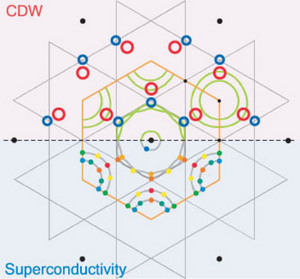Dec. 7, 2007 Research Highlight Physics / Astronomy
Competition boosts superconductivity
Superconductivity is found to be strengthened by a competing order of electrons
 Figure 1: A boost for superconductivity. The upper part of the figure shows the points in the electronic structure of 2H-NbSe2 where CDWs are found to exist (red and blue open circles). At the same points in the mirror image, superconductivity is enhanced (red and orange dots) compared with other areas (blue and green dots).
Figure 1: A boost for superconductivity. The upper part of the figure shows the points in the electronic structure of 2H-NbSe2 where CDWs are found to exist (red and blue open circles). At the same points in the mirror image, superconductivity is enhanced (red and orange dots) compared with other areas (blue and green dots).
Researchers at RIKEN’s Discovery Research Institute in Wako, in collaboration with colleagues at the University of Tokyo, have demonstrated that superconductivity of some crystals can be boosted by the presence of a competing electronic order, the so-called charge-density wave (CDW).
Crystals are comprised of a perfectly ordered arrangement of atoms. For many materials this regular arrangement, or atomic lattice, represents the most stable state over a broad range of temperatures and influences the behavior of electrons in the crystal. As such, electronic states such as superconductivity strongly depend on the interaction between the electrons and the atomic lattice.
However, there are electron–lattice interactions that compete with superconductivity. One example is CDW, where the density of the electrons varies periodically throughout the crystal. As superconductivity and CDW both compete for the same electrons, scientists assumed that these two electronic states exclude each other.
The researchers, led by Takayuki Kiss and Shik Shin, report in the journal Nature Physics 1 that they have found that these two states not only co-exist, but can strengthen each other. This discovery was enabled by recent advances in the spectroscopy technique known as ‘ARPES’, which is used to measure the electronic states of electrons moving in different directions of the crystal. “In the past, it was impossible to map the electronic structure with the necessary resolution … for example, in the 1990s, the energy resolution of ARPES was one to two orders of magnitude worse than at present,” comments Hidenori Takagi from the RIKEN team.
In the teams’ experiments, ARPES was used to map CDW in the energy diagram of the superconductor 2H-NbSe2. Simultaneously, the strength of the superconducting state was measured. Surprisingly, the researchers discovered that for certain electronic states, CDW actually enhances the superconducting state (Fig. 1). This finding suggests that the strong coupling between electrons and the atomic lattice is facilitated by the CDW and provides a positive feedback to superconductivity—as long as the CDW state is imperfect and provides room for superconductivity to develop as it does in 2H-NbSe2.
In the long term, the researchers are confident that, based on these findings, it might be a good idea to look for new superconductors with increased transition temperatures in systems related to the occurrence of CDW. Certainly, these results show that many aspects of CDW reach far deeper than originally thought.
References
- 1. Kiss, T., Yokoya, T., Chainani, A., Shin, S., Hanaguri, T., Nohara, M. & Takagi, H. Charge-order-maximized momentum-dependent superconductivity. Nature Physics 3, 720–725 (2007). doi: 10.1038/nphys699
